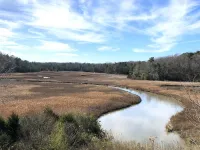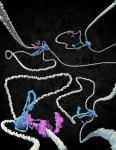(Press-News.org) UNIVERSITY PARK, Pa. — A Penn State-led interdisciplinary team of researchers across six institutions was awarded a $3.5 million grant from the National Science Foundation to investigate the role that macrobiota, such as clams, salt marshes and seagrasses, play in carbon cycling in estuaries.
“Estuaries are highly productive and diverse ecosystems and hence deserve study in their own right,” said Raymond Najjar, professor of oceanography and lead investigator on the project. “But estuaries also play an important role in the global carbon cycle, which regulates atmospheric carbon dioxide, the most important greenhouse gas.”
The global carbon cycle consists of the processes that transform and transport carbon on Earth. A key feature of the global carbon cycle is the transport of carbon from land to the open ocean. Before reaching the open ocean, the carbon carried by rivers must pass through estuaries, where significant transformations take place.
Many variables affect the form and amount of carbon in estuaries, including alkalinity, which is the capacity of a water body to neutralize acid.
“Alkalinity determines the extent to which carbon dioxide reacts with water to create chemical species that do not interact directly with the atmosphere,” said Zhaohui Aleck Wang, project collaborator and marine chemist at the Woods Hole Oceanographic Institution. “Therefore, alkalinity dynamics should be considered when studying the carbon balance of an estuary.”
Transformations of carbon and alkalinity in the ocean are dominated by microscopic life, like phytoplankton and bacteria. These transformations are also influenced by macrobiota; however, macrobiota are generally ignored in estuarine biogeochemical models and estimates of land-to-ocean fluxes of carbon and alkalinity, creating a gap in our knowledge and predictive capability, according to the researchers.
“We want to quantify how much macrobiota contribute to carbon and alkalinity dynamics and, if they have a significant influence, begin to include their effects in our quantitative models,” said Emily Rivest, project collaborator and global change biologist at the Virginia Institute of Marine Science. “Then we can predict how alkalinity and carbon, all the carbon dynamics, will be affected not only by a changing climate, but also by other changes, like loss of coastal marshes or oyster restoration.”
According to the researchers, adequate measurements of how macrobiota respond to the large seasonal and interannual variability of the estuarine environment are also lacking.
“Such measurements are essential for developing formulations of fluxes as a function of environmental conditions, which is necessary for representing point measurements in the spatially and temporally continuous manner demanded by numerical models and by efforts to represent macrobiota accurately in global marine carbon and alkalinity budgets,” said Cassie Gurbisz, project collaborator and coastal system ecologist at St. Mary’s College of Maryland.
The research will be carried out through a coordinated program of field measurements, laboratory experiments, historical data analysis and numerical modeling, all focused on the Chesapeake Bay.
In prior work the researchers found that alkalinity behaves very differently in different parts of the Bay. This research focuses on two contrasting tidal tributaries of the Chesapeake Bay: the Potomac River, where they found the alkalinity coming into the Bay was high; and the York River, where the alkalinity coming in was significantly lower.
“We are looking at two contrasting tidal tributaries of the Chesapeake Bay, the Potomac River Estuary and the York River Estuary, because they span the range of carbon and alkalinity dynamics found in estuaries worldwide,” said Edward Stets, project collaborator and research ecologist at the United States Geological Survey.
“These two tributaries also have a wealth of monitoring data on water chemistry, benthic fauna, tidal marshes and submerged aquatic vegetation that span decades and which we have only begun to mine, said Ryan Woodland, project collaborator and coastal ecologist at the University of Maryland Center for Environmental Sciences. “Finally, we have developed numerical models of this region that can be readily leveraged and improved upon.”
The project also includes creation of an affinity group, named "The Buffer Zone," which will connect high school and undergraduate students from a variety of programs working in the Chesapeake Bay region.
“The idea is to build a cohort of undergraduate researchers, largely from underrepresented groups, to participate in the research,” said Lora Harris, project collaborator and estuarine ecologist at the University of Maryland Center for Environmental Sciences. “Undergraduate students will serve as mentors to underrepresented high school students. For example, the Penn State Chapter of EnvironMentors will be participating in the project. Students also will present their research to managers and policy makers from the Chesapeake Bay Program during annual summits.”
The research team will also engage estuarine managers in the Bay area through presentations on macrobiota influence on biogeochemistry.
“This will help communicate our research findings to managers and help inform management and strategy policies, especially as climate change may impact related processes, such as tidal wetland loss and migration and acidification,” said Najjar.
Other Penn State researchers working on the project include Matthew Fantle, professor of geosciences; Maria Herrmann, associate research professor in the Department of Meteorology and Atmospheric Science; Jill Arriola, assistant research professor in the Department of Meteorology and Atmospheric Science; and Seyi Ajayi, postdoctoral scholar in the Department of Meteorology and Atmospheric Science.
Participating institutions include the Virginia Institute of Marine Science, St. Mary's College of Maryland, University of Maryland Center for Environmental Sciences, USGS and Woods Hole Oceanographic Institution.
END
NSF grant to investigate the role of macrobiota in carbon cycling in estuaries
2023-04-19
ELSE PRESS RELEASES FROM THIS DATE:
New blue light technique could enable advances in understanding nanoscale technologies
2023-04-19
PROVIDENCE, R.I. [Brown University] — With a new microscopy technique that uses blue light to measure electrons in semiconductors and other nanoscale materials, a team of Brown University researchers is opening a new realm of possibilities in the study of these critical components, which can help power devices like mobile phones and laptops.
The findings are a first in nanoscale imaging and provide a workaround to a longstanding problem that has greatly limited the study of key phenomena in a wide variety of materials that could one day lead to more energy-efficient semiconductors and electronics. ...
Study finds that child victims of violence face long-term psychological effects
2023-04-19
A study of young adults who were victims of violent injuries as children found significantly higher levels of post-traumatic stress disorder (PTSD) in this group than the general population.
The study – conducted by University of Rochester Medical Center (URMC) researchers – surveyed 24 respondents who were victims of gunshot, stab, or assault wounds as children between the years of 2011 and 2020. Of the participants, 15 suffered a gunshot wound, eight suffered a stab wound, and one was assaulted. Respondents were primarily teenagers at the time of injury, with a median age of 16.6 years. An average of six years had passed from the initial injury to the time ...
Association for Chemoreception Sciences (AChemS) 45th Annual Meeting
2023-04-19
Bonita Springs, FL— Smell, taste, and chemesthesis are vital chemical senses that contribute to the multidimensional sensation of flavor. Together with other sensory inputs, they allow us to enjoy eating and drinking. Understanding the fundamental mechanisms underlying these sensations is a primary focus of the annual conference of the Association for the Chemoreception Sciences, AChemS XLV. Other key areas include factors that modulate these mechanisms and their impact on fundamental behavior in a wide array of species. Attendees and members of AChemS are leading scientific and biomedical researchers dedicated to better understanding the function ...
As pandemic prison populations fell, proportion of Black prisoners rose
2023-04-19
New Haven, Conn. — The U.S. prison population plummeted during the early months of the COVID-19 pandemic but the percentage of incarcerated Black people rose, according to a new analysis of prison data published April 19 in the journal Nature.
The higher percentage of incarcerated Black people by mid-2020 was found in almost all states, and temporarily reversed a decades-long decrease in the percentage of Black people in the national prison population, researchers from Yale and Northeastern Universities and the Santa Fe Institute found.
While several factors contributed to the increase in percentage of incarcerated Black people during the height of the pandemic, researchers ...
Cannabis exposures in suspected suicide attempts are on the rise
2023-04-19
VANCOUVER, Wash. – Suspected suicidal cannabis exposures have increased 17% annually, over a period of 12 years, according to a Washington State University-led analysis of U.S. poison center data.
The vast majority of the attempts, more than 92%, involved other substances in addition to cannabis, and the data cannot show a direct causal link between cannabis and suicide attempts. Still, the findings are cause for concern, the researchers said, especially since the increase was more pronounced among children and women ...
Mind-body connection is built into brain, study suggests
2023-04-19
Calm body, calm mind, say the practitioners of mindfulness. A new study by researchers at Washington University School of Medicine in St. Louis indicates that the idea that the body and mind are inextricably intertwined is more than just an abstraction. The study shows that parts of the brain area that control movement are plugged into networks involved in thinking and planning, and in control of involuntary bodily functions such as blood pressure and heartbeat. The findings represent a literal linkage of body and mind ...
Race, ethnicity–adjusted age recommendation for initiating breast cancer screening
2023-04-19
About The Study: This study of 415,000 breast cancer deaths in female patients in the U.S. from 2011 to 2020 provides evidence-based race-adapted starting ages for breast cancer screening. The findings suggest that health policy makers and clinicians could consider an alternative, race and ethnicity–adapted approach in which Black female patients start screening earlier.
Authors: Mahdi Fallah, M.D., Ph.D., of the German Cancer Research Center in Heidelberg, Germany, and Tianhui Chen, M.D., Ph.D., of the Zhejiang Cancer Hospital in Hangzhou, China, are the corresponding authors.
To access the embargoed study: ...
Cognitive function in people with familial risk of depression
2023-04-19
About The Study: Depression in prior generations was associated with lower cognitive performance in offspring, whether assessed by family history or genetic data. There are opportunities to generate hypotheses about how this arises through genetic and environmental determinants, moderators of brain development and brain aging, and potentially modifiable social and lifestyle factors across the life span.
Authors: Breda Cullen, Ph.D., of the University of Glasgow in Glasgow, United Kingdom, is the corresponding author.
To ...
Nature publication on loops, flags and tension in DNA
2023-04-19
1 Cohesin loops DNA
It has been known for more than a century that the long DNA strands in cell nuclei are neatly folded into the characteristic shape of chromosomes, resembling bottlebrushes , in preparation for cell division. And also between divisions, chromosomes are organised into loops that are important for regulating the processing genetic information. In 2018, Dekker and his group were the first to visualise how SMC protein complexes such as condensin and cohesin extrude loops in DNA.
#2 CTCF flags have a direction and determine where a ...
Nature-study reveals new mechanism for DNA folding
2023-04-19
A hitherto unknown mechanism for DNA folding is described in a study in Nature published by researchers from Karolinska Institutet and the Max Planck Institute for Biophysics. Their findings provide new insights into chromosomal processes that are vital to both normal development and to prevent disease.
The DNA in our cells is organised into chromosomes, which are highly dynamic structures that are altered when genes are transcribed, when DNA damage is repaired or when chromosomes are compacte in preparation for cell division. These processes are affected by so called SMC protein complexes (SMC, Structural Maintenance of Chromosomes), which by mediating chromosomal interactions ...



